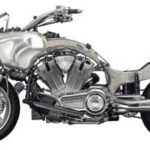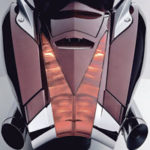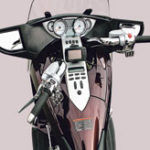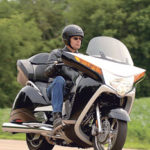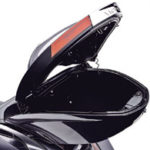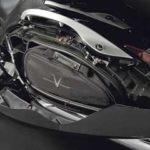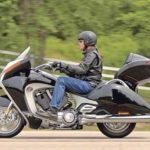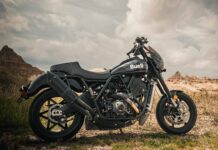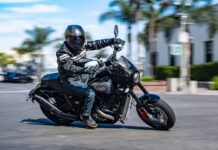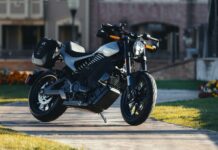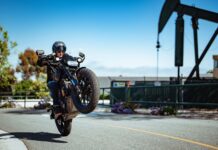Touring tour-de-force!
The Vision at last… and well worth the wait
Minneapolis, June 20–22—It’s been a long run-up to this launch. One that started with a set of four concept drawing teasers being flashed at the press a year ago, and followed in December by the displaying of preproduction specimens of the two envisioned Vision models, the Street and Tour, at another media event. No technical specs were let out of the bag at either event, nor were any forthcoming when Victory next exhibited the models at the International Motorcycle Show in New York City in January. The Visions next materialized at the Victory booth in Daytona Beach during Bike Week in March, again leaving the bike’s mechanical attributes shrouded in mystery, and shrouded from curious eyes by that elaborate carapace of bodywork, leaving observers to wonder what manner of beast they beheld; what configuration of chassis, and what means of propulsion. Was this an overwrought reworking of existing Victory engineering, or something truly revolutionary for the company? To be sure, the very notion of a luxury-touring model in the futuristic mode of a Honda Gold Wing or BMW K1200LT was in and of itself revolutionary for a manufacturer whose recent development strategy had favored fat tires and tribal paint. But when all was unmasked, would the bike be revolutionary in overall design as well? If all this yearlong intrigue wasn’t the Dance of Seven Veils, exactly, it was certainly the Dance of Three or Four.
When that final veil was finally shed in front of the moto-press corps and all attributes were exposed to critical scrutiny, the answer to that nagging question was answered unequivocally. The Vision was not just different in every pertinent detail from the Victorys that had come before, it proved so radically different that most of the assembled were taken utterly aback. In creating this model, the Victory team methodically revisited, reassessed, and reengineered virtually every component of their existing models, and clean-sheet designed a whole host of additional features specific to the bike’s luxury-touring mission.
Giving it some backbone
The chassis is the Vision’s most drastic and fundamental departure from the status quo. It’s hardly a chassis at all by conventional motorcycle norms, but rather a stout spine appended to a stout motor. It consists of four principal sections, the main one being the motor itself, which serves not merely as a stressed member of the configuration, but as the structural bedrock for the entire machine. Bolted up to the motor are beams of cast aluminum, the main section being the air box member, which does double duty as the induction for the injection system and the primary support structure for most of what’s bolted to the bike. Bolted up to that—and to the motor—is the rear member. It’s likewise a gnarly aluminum casting, and from it extends the final section, the long cast-aluminum swingarm. Together they form a tough, sturdy mass that gives the Vision impressive structural integrity, even while weighing 25 percent less than the chassis of the Kingpin Tour.
To this central block are fastened all the bike’s appurtenances, and a good deal of thought went into positioning those as well, starting with the gas tank which is constituted of a pair of cells hung low and well forward off the air box member for optimal weight distribution. Also positioned way down is the seat pan—so low, in fact, that even stacked with four inches of cushioning it presents a seat height of 26.5 inches. That height is comparable to that of their Kingpin models, and nearly four inches lower than the Gold Wing or K1200LT.
In order to get the seat that low, the Victory engineers designed a rear suspension that mounts a single spring-assisted, rising-rate air shock in an offset position on the swingarm. It articulates in tandem with a rod and levered arm mounted opposing it, perpendicular to the frame’s axis. This clever setup allows for a slammed saddle height while still giving the rear suspension over four inches of travel. The spring is preload-adjustable, and the air pressure in the shock is pumped up or bled off to suit load demands by means of a good old-fashioned Schrader valve accessed through the left pannier door.
The brake system is another area of innovation on the Vision. Referred to as a “linked brake system,” it’s different from the familiar integrated brake systems used for years on Moto Guzzis and Hondas in that, rather than having the brake pedal actuate both the rear disc brake and one of the front discs, it employs a proportioning valve positioned in-line with the rear brake’s hydraulic system, and a second valve—called a delay valve—in the plumbing of one of the front disc brake hydraulic circuits. Under normal, predictable braking the system operates like you’d expect, with the hand lever operating the front calipers, and the brake pedal squeezing the rear caliper. In panic mode, a heavy foot on the brake pedal overrides the delay valve, and shunts a portion of the rear brake’s hydraulic pressure into dual-disc front brake duty. In practice, it functions as a sort of poor-man’s mechanical ABS, distributing brake force and helping to prevent the rear wheel from locking up in hard stops.
Another novel bit of engineering on the Vision is its subtle incorporation of “tip-over” structures that in another time would be referred to as “crash bars.” Not that they look the part one bit, and upon casual inspection you’d never spot them for what they are. The elongated platforms in front of the operator floorboards (that serve handily as highway footrests for stretching out the legs), and the broad platforms beneath the passenger’s floorboards are actually rigid extensions of the Vision’s chassis and designed to take the worst of it should the bike fall over—thus protecting all of that expensive bodywork from damage. That’s what the factory claimed, anyway, and while it’s on the to-do list of any conscientious motojournalist to get around to testing that type of claim, it’s also the to-do thing you never seem to get around to doing, sort of like cleaning out the eave troughs.
Fortunately, however, one of my professional colleagues at the press launch proved more conscientious than the rest of us and executed a brilliant lay-down, flip-over, high-side dismount of a test Vision, and he wasn’t going slow at the time. He was going fast enough that the crash would have resulted in a buttload of damage on most big bikes, and would have rendered most unrideable. Here, though, the bike sustained only minor cosmetic mars on the fairing and pannier, and folded an operator floorboard up on its hinges where it stayed, wedged by the slightly tweaked “tip-over” feature. Victory’s head honcho—and AMA Hall of Fame motocross racer—Mark Blackwell swapped bikes with our conscientious colleague and rode off on the damaged goods. He may have even preferred the bike in that condition, knowing the racer mentality.
A new motor, too
To fortify their Freedom 100/6 powertrain for heavy-duty long-distance touring duty, Victory gave it an epic makeover, starting with upping the displacement to 106 inches. This modification involved much more than simply lengthening the stroke, though, since any increase in stroke would bring with it vibrational characteristics they were determined to avoid. Their objective in tinkering with a proven motor was to make it even smoother, quieter, and more powerful than it had been before, all in keeping with the requisites of true luxury touring. So along with a longer stroke, the new Freedom 106/6 got reshaped pistons and rods that shave off reciprocating mass, keeping it comparable to that of the smaller displacement unit. They also redesigned the crankshaft and put in camshafts with cam profiles that reduce the closing velocity of the valves to quiet down the top end. A completely redesigned fuel injection system uses a new ECM, injectors, O2 sensors and a 45mm dual-bore throttle body. It also features “automatic cold-start compensation” which is a fancy way of saying that the familiar choke lever of previous Victory generations is gone from the left-hand control.
The Freedom 106/6 also brings a number of solid improvements to the primary case, where a retuned ramp compensator works with a new spring-loaded split-gear clutch to reduce idle noise and generally smooth out performance. A stiffened primary cover reduces radiated noise from within. The Vision’s 6-speed overdrive transmission lowers the gear ratio in first gear to improve slow-speed maneuvering, and it ups the overdrive ratio in sixth gear to reduce cruising engine speeds by 3 percent while also reducing resonant noise from the motor.
Cockpit control center
The Vision’s tank console is dedicated almost entirely to accommodating the suite of electronic gizmos compulsory in the Luxo-tourer genre. The Vision Tour and Street both come stock with a premium audio system consisting of a multi-band radio and speakers, and it’s configured for quick plug-and-play installation of the peripherals of your choosing: XM satellite reception, CB/Intercom, GPS, and MP3 player/ iPod. Interestingly, Victory chose not to include a CD player except as a trunk-mounted option. The thinking here, we’re told, was that they see that technology as dated in these days of iPod dominance, wherein you can store the total tracks of 100 CDs in a remarkably tiny device that slips into a compartment beside the console. With the exception of the GPS, which is a Garmin touch-screen unit that mounts on a console stand, the remaining devices are read and controlled by the Vision’s electronic brain, with all information appearing on a small, easy-to-read screen and all device/band/track selection and programming managed with a set of large buttons that are easy to use even in gauntlets.
Mounted in the fairing is an array of instrumentation that includes the basic speedo, tach, fuel gauge and oil pressure gauge, but goes beyond that to a digital readout screen that reports a wealth of information. Gear selection is the most prominent, with the number of the gear you’re in appearing big and bright in the middle of the screen, but beyond that you can check ambient temperature, tripmeters, miles to reserve, on-the-fly fuel usage, and average fuel economy among other things. A trigger on the left grip lets you toggle between screens to find the information you seek.
With the touring rider in mind
Operator-friendly details abound on the Vision, and it’s obvious that Victory gave a lot of practical consideration to the little things that make life in the saddle more convenient and enjoyable. The fuel door on the tank cover, for example, has a locked lid for security but you needn’t remove the key from the ignition to unlock it. Just twist the key to the left and the lid springs open. Beneath the lid is the fuel cap, and beside it is a handy form-fitted recess to hold the cap while filling up. Another thoughtful detail is the 12-volt outlet in the console compartment where the iPod nestles. You can plug your cell phone in and store it in the compartment with your tunes. There’s another outlet in the trunk, and wiring for additional outlets reside just under the tank console and behind the passenger armrest for easy access should you choose to add exterior outlets for plugging in electric clothing. Not that you’ll necessarily need electric clothing since the Vision offers heated handgrips and a heated seat, which should go a long way towards warding off the chill in most situations.
The trunk and panniers on the Vision are lockable, easily accessed, and will hold a fair amount of gear—the trunk can handle a pair of full-face helmets. For additional capacity, Victory offers a luggage rack/ passenger backrest for the Street model and a trunk-mounted luggage rack for the Tour. The trunk on the Tour can also be easily removed and replaced with the Street’s plain panel for more stripped-down profiling, or swapped out for the Street’s luggage rack/backrest for packing on bulky duffel bags or camping gear.
In the wind… and the rain
During the two days and some 450 miles of touring aboard the Vision at this press ride, the threat of rain was our constant companion—except, of course, for those times when it was actually raining. Creative route planning and frequent heads-up route adjustment while on the road kept us skirting the most evil-looking skies, but it was only a matter of time before we’d run out of avenues of escape and have to face the rainy-day music.
That time was presaged by the ambient temperature readout on the Vision’s dash screen. It started dropping quickly, and in a span of a dozen miles had dropped 12 degrees from 78 to 66 as we coursed into the frontal boundary and the rain drops came with ever-greater intensity. Just how intense could be judged by observing the wiper blades of oncoming cars and trucks. As we rode into the storm the wiper speeds increased from intermittent to steady to flailing, and that told me we were in a decent downpour. But that’s the only way I could really tell. I was riding in it, but aside from the drops that got under the windscreen—I’ll explain in a moment—I was remaining utterly dry. I was riding in it, but I was getting hardly any of it on me. That remained the case even as we slowed down, and as long as we had any forward motion going at all, the rain continued to sluice away on the slipstream.
After an extended period in the wet, being hosed with water from both the sky and the pavement, I found to my absolute amazement that my pant legs and boots were virtually bone dry, and that’s the part of you that normally gets the most thorough soaking in those conditions.
This was where all that computer modeling and wind tunnel testing of the Vision’s bodywork paid off handsomely. Those tests demonstrated a virtual cocoon of mild air within the windblast, and the only portions of the operator’s anatomy that protruded from the cocoon were his kneecaps. A pair of retractable wind deflectors at the lower corners of the fairing fixed that exposure while still permitting some cool airflow in hot conditions. Also instrumental in tailoring the Vision’s ride to conditions is the adjustable windscreen that can be raised or lowered manually on the base Visions, or electronically on the more tricked-out models. With the screen in its lowest position it’s easy to see over, like most touring riders prefer to do. In really chilly or high-speed operation the screen can be raised to its highest setting to cut the blast, and when it’s in that position it also opens a slot at the bottom to create a separate updraft of air. That calms things down even more in the cockpit, while keeping things ventilated. The downside of that setup is evidenced in a hard rain when the droplets start finding their way in through the slot and scattering up the screen and over the dash at the operator. Lowering the screen slightly to close off that airway seals things up nicely.
In the final analysis
The Vision is an impressive piece of work in every stylistic and functional category. The bodywork is beautifully integrated and flawlessly finished with no visible fasteners anywhere. On the highway the big machine’s tracking is dead straight and stable, handling is essentially intuitive, and the cornering clearance is remarkable for this style of motorcycle. The power on tap at any speed is substantial, quiet and vibration-free, and the bike will run well up into triple digits without breaking a sweat or blurring a mirror. The seat is plush both fore and aft, and operator foot room is unsurpassed. And best of all, from a serious touring perspective, the Vision provides the most effective weather protection we’ve experienced on two wheels.
The Vision is offered in five models, two Street versions and three Tour versions, with pricing ranging from $18,999 to $21,499.


